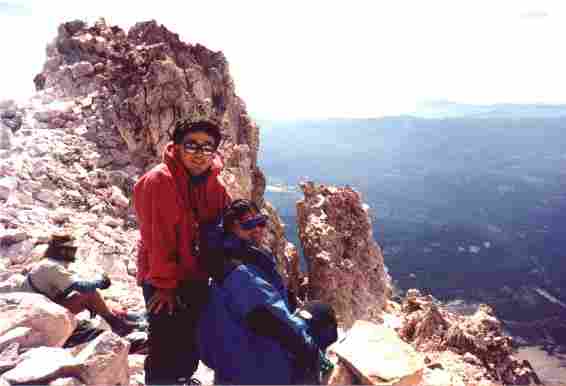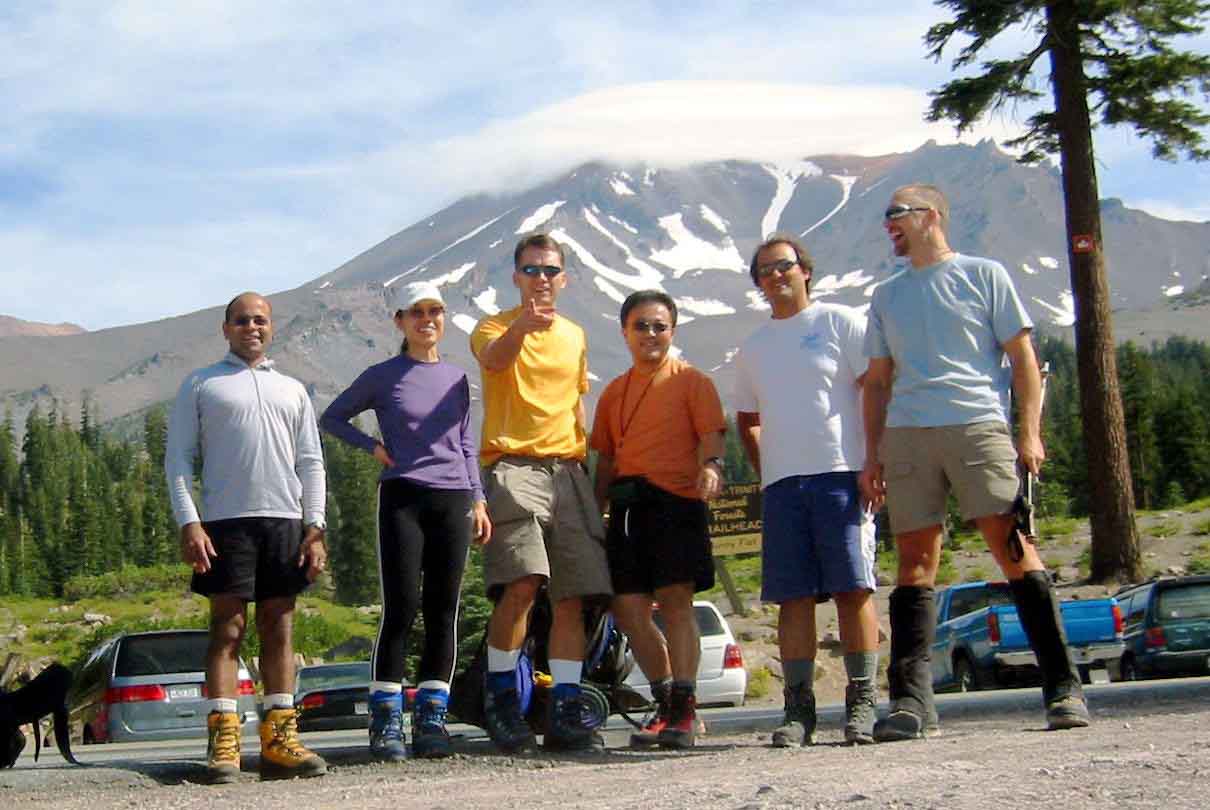 Summit of Shasta with Chris Wee in 1994
Summit of Shasta with Chris Wee in 1994 |
|
|
|
|
|
|
Climbing
Mt. Shasta
 Summit of Shasta with Chris Wee in 1994
Summit of Shasta with Chris Wee in 1994
Before signing the logbook at the summit on
my first ascent, I checked for someone from Brazil and found none. So mine
the glory is. Unless someone proves otherwise, I was the first Brazilian
to summit Mt. Shasta during Labor Day weekend in 1994.
After that I've been back to Shasta a few times:
- Labor Day 1994, Avalanche Gulch, summit by
mid day, with a group of friends led by Chris Wee
- October 1994, with Kehyoe and Bernard Ng, Hotlum Glacier, did not summit
- Labor Day 1998, Avalanche Gulch, summit by mid day, with a group of
firends led by Sandeep
- Independence day 2004, Avalanche Gulch, solo to Red Banks in one day
(preparation for next trip)
- August 2004, Avalanche Gulch, with 5 first-timers, 4 summited
- June 2005, Avalanche Gulch, got caught inn a storm on first day, but was
able to summit

Mt. Shasta, 14162ft (4317m), a beautiful volcano in Northern California, is one of the highest in Continental US (the highest being Mt. Whitney at 14450ft) and a major peak of the Cascade range. It is somewhat of an anomaly since there are no surrounding peaks of comparable height. Its base is more than 17 miles in diameter. It has 8 glaciers, including the largest in California.
The South Face (Avalanche Gulch Route) is easier
to climb. The North Face is more difficult and technical and should be left
to people with more experience. Best time to climb is from early July to
mid-August (good wheather, still lots of snow).
While not a technical, a Mt. Shasta climb presents
serious risks (avalanches, glacier crossing, AMS) and should not be attempted
without proper equipment, preparation, and planning. The leader of the climbing
party should have experience (preferably Shasta specific) and every member
should be familiar with the basic safety equipment (ice axe, crampons), self-arrest
procedures and be fit for the climb.
A typical South face schedule looks like:
Day 1: Start by mid-morning from Bunny Flats
(6500ft). Fill the water bottles at Horse Camp and proceed to Lake Helen
(10500ft) by mid-afternoon. This should take betwen 4 and 7 hours, depending
on how fast the group moves. The earlier you find snow, the better. In 94,
we had to scramble through lose rock (no snow) all the way to Lake Helen.
You want to arrive to Helen at least 3 hours before sunset so that you have
time to get settled, melt ice, cook, and go to bed early.
Day 2: Start very early (before 5AM) so you get to Red Banks before the sun hits and start softening the snow. Climb through the chimneys and up Misery Hill. Cross the snow bridge and summit by mid-day (ascent should take 6-8 hours). Descend back to camp at Lake Helen and, depending on your schedule spend one additional night there or descend all the way back.
In 94, there was a pit toilet at Lake Helen. In 98 things had changed and all climbers are required to pick a kit at the ranger station and pack out all the "human waste". While this may sound inconvenient, I think this is very reasonable and helps keep the mountain cleaner.
There is no potable water after Horse Camp and
you will need to melt snow at Lake Helen and purify
the water
(using iodine or filters).
For a Mt. Shasta climb, you will need winter
equipment (4-season tent, white gas stove, good sleeping bag, etc), carry
an ice axe and use crampons with compatible boots. Helmets are recommended
(guess why "Avalanche Gulch"...). Check for the
equipment checklist
.
First Climb: September 1994.
In the first expedition during the labor day weekend in 1994, we had little snow and a group of 6 people. Four of us (Chris, Michelle, Mario, Marcio) summited around 1:30pm PST on Mon. Sept 5, 1994.

(Sunrise from Red Banks, Mt. Shasta, 1994)
Second Climb: October 1994.
In the same year, I had a planned an expedition to Mt. Rainier (a lot more technical) with two experienced friend climbers. We cancelled at the last minute (one of them could not make it). Instead, we went to Mt. Shasta again, this time from the North Face (Hotlum Route, more technical).
We did not summit. Bernard and Keyhoe had AMS while camped at about 11,000 ft, before we could try a summit bid. It was not a good idea to try to cross a glacier alone.

(Dancing clouds around the summit - North Face, 1994)
Third Climb: September 1998.
Then, in 1998, we did the Avalanche Gulch route again. This time, there was a lot more snow and I had more experience, was better prepared, was more relaxed and really enjoyed the climb. It was the first summit for Isa and Carlos.

(98' Summit, Sandeep, Isa, Carlos)
|
|
|
|
|
|
|